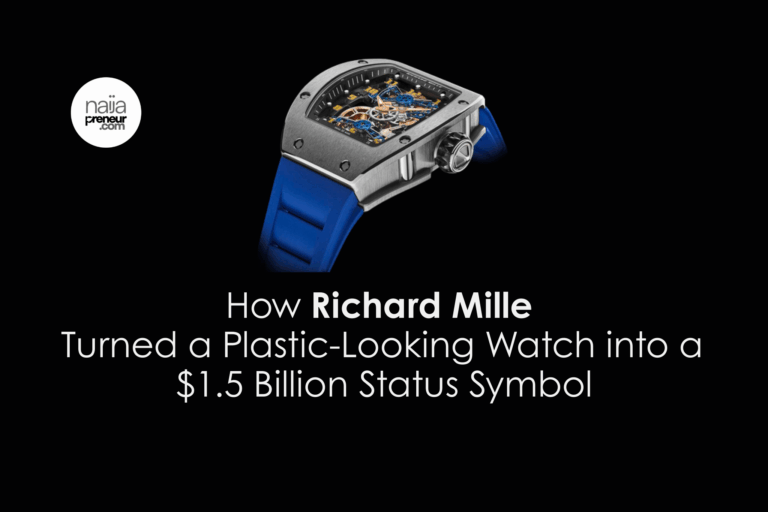In 2012, Richard Mille wasn’t a household name. No century-old legacy. No royal endorsements. No golden heritage. Just one audacious idea.
At Baselworld—the “Super Bowl” of luxury watches—he unveiled what looked like a plastic toy: the RM 056. Priced at an eye-watering $1.65 million, this watch didn’t just turn heads—it shattered industry norms.
And with that move, Richard Mille created one of the greatest marketing stunts in modern luxury history.
From Outsider to Empire
Richard Mille was never meant to fit in. Unlike Rolex or Patek Philippe, he didn’t build on tradition—he built against it.
He launched his brand in 1999 with a radical vision:
-
Use racing-grade materials
-
Expose the full mechanics
-
Ditch gold and diamonds
-
Keep production ultra-limited
Mille partnered with Renaud & Papi, legendary Swiss movement makers known for their technical wizardry, and gave them one brief:
“Build a machine for the wrist.”
It was risky. The designs were polarizing. Many traditionalists mocked him. But Mille wasn’t after tradition—he was after transformation.
The Watch That Changed Everything
By 2012, the brand had built a small following among ultra-wealthy collectors. But Mille needed a breakout moment.
Enter the RM 056—a watch made from transparent sapphire crystal and quartz-carbon materials, with a look closer to a sci-fi gadget than a Swiss heirloom.
To some, it looked cheap. To Mille, it looked disruptive. Priced at $1.65 million, the RM 056 didn’t just make headlines. It redefined what a luxury watch could be.
Instead of apologizing for breaking norms, Mille leaned in. The price wasn’t a bug—it was the feature.
Many thought the stunt would tank the brand. Instead, it became the blueprint.
Richard Mille’s 5-Step Playbook for Selling to the Super Rich
Here’s how Mille used psychological and branding genius to dominate a market ruled by old money:
1. Scarcity Over Superiority
People don’t crave what’s best—they crave what’s rarest.
-
Rolex says: “You’ve made it.”
-
Mille says: “You’ll never make it here.”
By intentionally keeping production low, Mille created social moats—making the watches desirable not just for their quality, but because of their inaccessibility.
2. Price as a Status Weapon
Entry-level Richard Mille watches start at $200,000. Many models go well over $1 million.
This wasn’t about affordability. It was about drawing a line:
“You’re either in the club, or you’re not.”
Price became the gatekeeper, not the barrier.
3. Plastic as Power
Old luxury screams with gold and diamonds. Richard Mille whispered with carbon and quartz.
To the average person, it looked “cheap.”
To the elite, it signaled confidence—a flex that says, “I don’t need to prove my wealth the old way.”
By making “plastic” elite, Mille inverted the hierarchy of luxury.
4. A Visual Break from Tradition
Most luxury watches are round, restrained, and elegant.
Mille’s watches are loud, angular, and aggressively modern. The unique design grabs attention—because in high-stakes status games, attention equals power.
The bold look created an instant visual identity. Even from a distance, you knew: That’s a Richard Mille.
5. Celebrity in Motion
While other brands dress celebrities for red carpets, Mille took a different route.
He put $1M watches on athletes in action:
-
Rafael Nadal wore one at Wimbledon
-
Lewis Hamilton races in one
-
Yohan Blake sprinted the 100m in his
This was brilliant: it proved the watches were tough, functional, and trusted by elite performers—giving Mille credibility that marketing money can’t buy.
Mille Didn’t Imitate Rolex — He Outgrew It
Today, Richard Mille is a $1.5 billion empire. And unlike most brands chasing heritage, Mille created a new category:
Modern luxury for the ultra-wealthy who value design, scarcity, and individualism over tradition.
From tech billionaires to crypto elites to pro athletes, Mille’s audience doesn’t want to fit in—they want to stand apart.
And that’s exactly what his brand offers.
Takeaway for Entrepreneurs:
You don’t need history to win.
You need sharp positioning and a bold idea.
Richard Mille didn’t try to be Rolex.
He rewrote the rules of luxury—and the market followed.
The lesson?
In a crowded world, don’t play by the old rules. Create your own game.
Now ask yourself:
What’s your $1.65 million idea?
What bold move can you make to stand out, not fit in?

